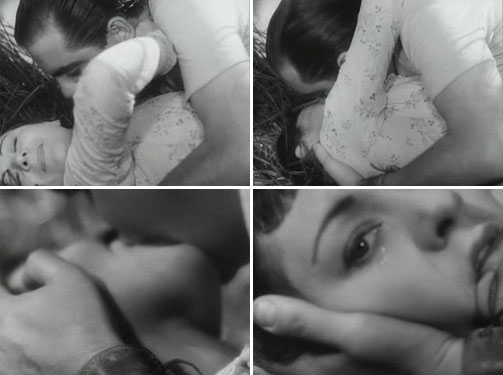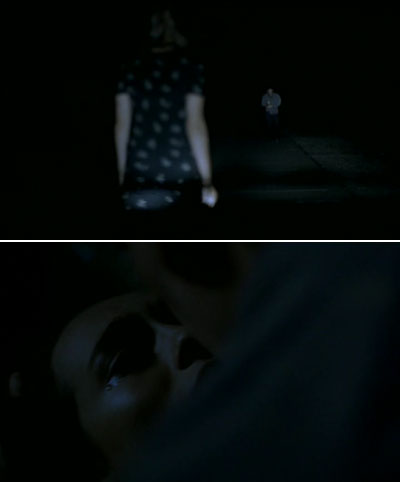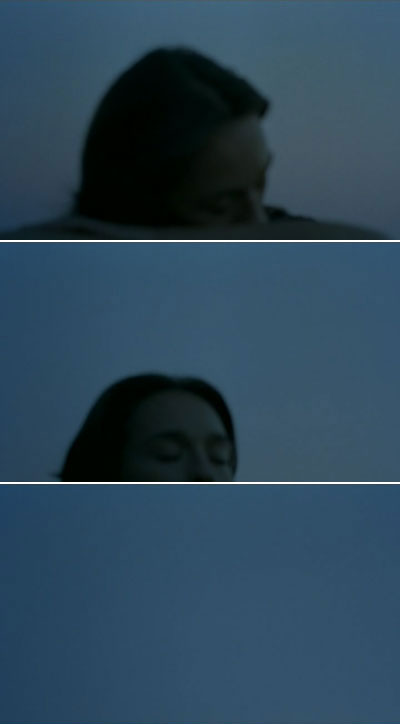Sombre / Partie de campagne
Precisar a Renoir
Click aquí para la versión en inglés
Escondida entre las hierbas, la joven se debate, rechaza el abrazo que la amenaza, una pausa, ella se abandona, lanza sus brazos alrededor de su amante y lo besa con locura. Su rostro, sostenido por la mano del hombre como por un pedestal, se vuelve hacia nosotros en un extremo primer plano; una parte de su cara en ángulo oblicuo, su ojo de cierva húmedo por las lágrimas.
El filme es Una partida de campo (Partie de campagne, Jean Renoir, 1936), y la escena es el abrazo matrixial de Henriette (Sylvia Bataille) y Henri (Georges Darnoux).
Entonces todo se convierte en pregunta, pero de acuerdo a formas que son más o menos resueltas y aceptadas por la propia película:
• Pregunta/respuesta: ¿Por qué la chica acepta repentinamente este abrazo que la desflora y acabará devastando su vida? La totalidad de la película grita la respuesta: porque ella ha sentido «esa especie de ternura… por todas las cosas…»; la joven admite, dentro de ella misma, la existencia de una criatura atravesada por el flujo vital del deseo universal y es eso lo que la empuja a los brazos del hombre. El salto gestual que, en el mismo plano, la lleva del rechazo ansioso al abrazo apasionado, da sentido al hiato entre el sujeto social (Henrietta) y el cuerpo deseante (la virgen palpitante): esa falla de donde puede nacer la locura.
• Preguntas construidas como preguntas sin respuesta: ¿Se siente ella mal? ¿Está gozando? ¿Ha comprendido el deseo? Bajo sus lágrimas y sus ojos de pequeño animal, el dolor, el placer y el misterio de lo orgánico se confunden para siempre.
• Preguntas puestas fuera de campo y, en cierto modo, economizadas por la película: y el hombre ¿qué sucede con él? En el fondo, ¿existe o es solo el instrumento ocasional del deseo femenino?
El genio de Sombre (Philippe Grandrieux, 1998) consiste no en contestar las preguntas lanzadas por Una partida de campo, sino en plantearlas como problemas. Esto significa:
1. Desplegar figurativamente la invención renoiriana a partir de tres soluciones:
• Escenificar el gesto del hiato entre el rechazo del deseo y su necesidad imperiosa. Esto da lugar a la constitución de una tríada de personajes: Jean (Marc Barbé), el deseo en su estado bruto, la pulsión, el ello (ça) que siempre vuelve y no se detiene jamás, ni siquiera cuando está herido, tumefacto, medio muerto; Claire (Elina Löwensohn), la interpretación del deseo únicamente en términos de entrega, sin que este pase por su propio cuerpo; y Christine (Géraldine Voillat), el cuerpo cotidiano del deseo, permitido, voluptuoso, socializable y, por lo tanto, sometido a accidentes (ella será ahogada, golpeada, atada, evacuada, acompañada fuera de la película).
• Volver incesantemente al motivo del abrazo al colocarlo en una serie (serial killing) y, de este modo, agotar la interpretación estándar de ese abrazo en tanto que violación y asesinato. Sombre es perfectamente clara en este aspecto: penetrar a una mujer no es querer entrar en ella, sino querer re-entrar y volver, de nuevo, a su vientre a través de su boca o de su sexo. En algunos filmes —los de Herschell Gordon Lewis o Dario Argento, por ejemplo— el hombre puede abrirse paso a través de cualquier orificio: el ojo, la oreja… Y en otros casos (innombrables), solo puede re-entrar creando él mismo la abertura, por medio de cortes, incisiones y heridas insanas.
• Consagrar una secuencia al estudio visual de los planos de la desfloración: la unión de Claire y Jean al pie de la carretera mezcla el espacio de La bestia humana (La Bête humaine, Jean Renoir, 1938) —el terraplén y los escombros donde se encuentran Lantier (Jean Gabin) y Sévereine (Simone Simon, con destino a La mujer pantera)— con la gestualidad de Una partida de campo. Cuando La Pasión según San Juan de J. S. Bach aparece transferida a la siguiente secuencia, tal y como Pialat transfirió el grito de duelo en su Van Gogh (1991), estamos seguros retrospectivamente de que Claire tiene lo que quería. Pero ella no quería probar el placer, ella no quería gozar, ella solo quería llorar («Tú me has entendido, eso me hace llorar»). Entonces, volvemos a ver las lágrimas de Henriette, pero esta vez ya no como emblema de un signo complejo y misterioso, sino como un fin en sí mismo: Sombre recuesta sobre sí la imagen de Una partida de campo, y nos la devuelve quieta y calma, como si una película pudiera tranquilizar a la otra, decirle que sí, que está bien que haya encontrado lo que buscaba, que todo estaba allí, que todo está allí…
2. Completar las figuras de Renoir:
• Primero, la figura que en Un día de campo es tratada casi como un ectoplasma: la de Henri. A su alrededor, los otros tres personajes masculinos —el Padre, el Prometido y el Fauno (Jean constituye la versión aterradora de este último) —, conducen al filme al terreno de lo burlesco y lo grotesco. Con Jean, el infantilismo de los hombres renoirianos deviene, otra vez, espíritu de infancia (las marionetas, el cuento), es decir: puro pavor. El contorno blanco, pálido y veleidoso de Henri se llena de negro, se hace más espeso y denso en un personaje con necesidades sexuales brutas. Pero ¿cambia eso las cosas? No, porque las premisas son las mismas: en ambos casos, son las chicas las que llaman al lobo, el raccord vertiginoso —entre la niña que grita a las marionetas y se inclina hacia la parte inferior del cuadro, y el plano en ángulo picado de un inmenso valle que tiembla— nos asegura que hemos caído en el perturbador campo del deseo femenino. Así, mientras Un día de campo hace que la naturaleza, tratada como paisaje y como principio, englobe todos los fenómenos, Sombre se hunde en el abismo del deseo arquitectónico de las mujeres.
• Después, gracias al epílogo sobre el Tour de Francia, Sombre sustituye la pesca por el ciclismo y, al hacer esto, flanquea la figuración de su fuera de campo, es decir: el mundo cotidiano, material y sensible de la ilusión sentimental —ese que, en forma de cebo, de ficción o de frágil romance, mantiene, a duras penas, el vínculo entre los hombres—: los travellings que cierran el filme reencuentran los paisajes del valle, pasan por el exterior ordinario de aquello que el filme ha descrito como un interior muy violento, y cantan el sentimiento de amor que la película ha tratado solo en términos de necesidad. La vida en común de los hombres, transfigurada por semejante inmersión psíquica en una extrañeza inquietante, admite también su carácter recíproco de abominable familiaridad, la cual ya solo puede ser tolerada por el movimiento ascendente de los planos y de la canción —que desata, además, una dimensión nostálgica—.
3. Problematizar las preguntas de la obra de Renoir al devolverlas a sus orígenes:
• ¿Qué hacer con el acto del sexo? ¿Qué son esos gestos, de dónde vienen? ¿Podemos prescindir de ellos? Sombre crea un personaje para regular esta cuestión: la mujer que ha vivido un amor imposible y sin contacto físico, construido solo sobre la palabra y la ficción. Ella hace que la angustia de Claire se disipe, que su figura se hunda lentamente hasta ser eclipsada por la parte inferior del cuadro (como sucedía con las hermanas en Vampyr de Dreyer) mientras escucha contar aquello que ya sabía: sin sexo, la vida está vacía, se escapa, se evapora en la náusea de la ausencia. Entonces: es la pesadilla del cuerpo (el horror) o la náusea de la falta (la angustia). El naturalismo trágico de Renoir (Henriette, siendo a la vez Claire —la que se entrega por completo— y la mujer anónima —la que ha vivido sin amor—, vuelve como una figura de desgarradora melancolía) está fundado en una realpolitik de la pulsión.
Entre otras invenciones plásticas y formales brillantes, Sombre introduce, con gran elegancia, una nueva relación en la historia de las formas intertextuales: precisa las imágenes de donde viene (las detalla, las reconforta, las construye a fondo, las problematiza) y, al hacer eso, nos las devuelve más preciosas todavía.
Traducción: Cristina Álvarez López
![]() Este texto apareció publicado originalmente en Simulacres (Paris), nº. 2 (Mayo 2000).
Este texto apareció publicado originalmente en Simulacres (Paris), nº. 2 (Mayo 2000).
Texto original © Nicole Brenez, febrero 2000 / Traducción al español © Cristina Álvarez López, junio 2012
To Nuance Renoir
Click here for the Spanish version
Hidden in the grass, a young woman fights, pushes away the sexual embrace that is scaring her; a pause, and then she lets herself go, throwing her arms around her lover and wildly kissing him. Match-cut on this kiss, then her face, held in the man’s hand like a plinth, turns towards us in extreme close-up; we get an oblique view of part of her face, her doe’s eye wet with tears.
The film is Jean Renoir, Partie de campagne (Day in the Country, 1936); and the scene, just short of the 33 minute mark, is the matrixial sex-embrace of Henriette (Sylvia Bataille) and Henri (Georges Darnoux).
Everything here becomes a question, but according to forms that are more or less resolved and accepted by the film itself:
• Question/answer: why does the girl suddenly accept this embrace which deflowers her, and will devastate her life? The film’s totality cries the answer: because she has felt “a sort of tenderness … for all things …”, the young girl admits, within herself, the existence of a creature traversed by the vital flow of universal desire; it is this which pushes her into the man’s arms. The gestural leap that, in a single shot, takes her from anxious refusal to abandoned entanglement makes sense of the hiatus in time between the social subject (Henriette) and the desiring body (palpitating virgin) – this fault-line where madness can be born.
• Questions posed that have no answer: is she feeling bad? Is she enjoying herself? Has she understood desire? In her tears, in her little-animal-eye, the pain, pleasure and mystery of organicity are forever fused.
• Questions set aside, yet in some way economised by the film: so, the guy, what becomes of him? Does he, basically, even really exist, or is he merely the occasional instrument of female desire?
The genius of Philippe Grandrieux’s Sombre (1998) lies not in answering but posing as problems the questions raised by Partie de campagne. This means:
1. Deploying Renoirian invention figuratively, along three axes.
a. Scenarising the gesture of hiatus between the refusal of desire and its imperious necessity. This gives rise to the constitution of a triad of characters: Jean (Marc Barbé), desire in its raw state, the drive, the ‘it’ (ça) that always returns and can never be stopped, even when utterly damaged, left swollen, half dead; Claire (Elina Löwensohn), the interpretation of desire solely in terms of a gift of the self, without even going through its own body; and Christine (Géraldine Voillat), the everyday desiring body, sanctioned, voluptuous, socialisable, thus subject to accident (she will be drowned, beaten, tied up, abandoned, escorted out of the film).
b. Ceaselessly returning to the motif of the erotic embrace by placing it in a series (serial killing), to the extent of exhausting its standard interpretation as rape or murder. Sombre is perfectly clear on this point: to penetrate a woman is to want not to enter but to re-enter her, thereby returning to or reinstalling oneself in her belly via her mouth or her sex. In other films – by Herschell Gordon Lewis or Dario Argento, for example – man enters woman via any hole whatsoever, eyes, ears … And in yet other (unspeakable) cases, he enters only by his very own creation of an opening, by means of insensible incisions, injuries and wounds.
c. Devoting a sequence to the visual study of deflowering shots: the union of Claire and Jean alongside the highway mixes the space of Renoir’s La Bête humaine (1938), its embankments and trash heaps where Lantier (Jean Gabin) and Séverine (Simone Simon, en route to Cat People, 1942) cross paths, with the gestural language of Partie de campagne: when Bach’s St John Passion appears, transferred to the following sequence just as Maurice Pialat transferred the mourning cry in his Van Gogh (1991), we are sure, retrospectively, that Claire has got what she wanted. But she didn’t undertake the experience for pleasure, she didn’t want to enjoy herself – she only wanted to weep (“You’ve understood me, that makes me cry”). So, we re-see Henriette’s tears, but this time happening not at the level of a complex and mysterious sign, but as an end in itself: Sombre steadies the image from Partie de campagne on itself, rendering it still and calm, as if one film could reassure another, telling it: yes, it’s good that you found what you were looking for, it was everything, it is everything …
2. Completing Renoir’s figures.
a. First, the figure whom Partie de campagne treats as almost an ectoplasm: Henri. Around Henri, three other male characters, the Father, the Fiancé and the Fawn (Jean constitutes the panicked version of this third character) draw the film to the side of the burlesque and grotesque. In Jean, the infantilism of Renoirian men becomes the ancestral spirit of childhood (puppets, fairy tale), i.e., pure fright. The white, pale, irresolute profile of Henri, disappearing into darkness, now fills out and thickens into a character of raw sexual need. But does that really change anything? No, because the premises turn out to be the same: in both cases, it is women who call forth the wolf, and Sombre’s vertiginous match-cut – between a little girl who, while screaming at the puppets, bends towards the bottom of the frame, and the high angle on a vast, trembling valley – assures us that we have fallen into the frightful field of female desire. Thus, where Partie de campagne portrays nature, both as landscape and as principle, Sombre loses itself within the architectonic desire of women.
b. Second, thanks to its Tour de France epilogue, Sombre replaces Renoir’s fishing party with cycling, and thereby flanks the figuration of its off-space, i.e., the daily, material, sensible world of sentimental illusion, which maintains, with difficulty, connection between men under the sign of lure, fiction and fragile romance. The finale’s tracking shots refind the valley landscapes passing across the ordinary exterior that covers such a violent interior as that which the film has described; and they sing the sentiment of love that the film has treated only in terms of need. The shared life of men, transfigured by this psychic plunge into disquieting strangeness, lays bare its reciprocal nature of abominable familiarity – which we might not be able to accept if not for the ascending movement of the shots and the song (Elysian Fields’ cover of Serge Gainsbourg’s “Les amours perdues”/”Lost Loves”) which, too, triggers a nostalgic dimension.
3. Problematising the questions at work in Renoir, by taking them back to their origin: what do you do with the act of sex? What are its gestures, and where they come from? Can we do without it? Sombre creates a character in order to adjudicate the question: the woman who has experienced an impossible love, without physical contact, built upon speech and fiction – she serves to evaporate the anguish of the Claire figure, who slowly falls away as she is eclipsed by the bottom edge of the frame (like the sisters in Dreyer’s Vampyr, 1932) while hearing the tale of what she already knew: without sex, life is empty, it flies away, disappears in the nausea of absence. So: there is the nightmare of the body (horror) or, equally, the nausea of lack (angst). Renoir’s tragic naturalism (Henriette – being at once Claire who utterly gives herself and the anonymous woman who has lived without love – returns in this dual figure of tearing melancholia) is now founded in a realpolitik of the drives.
Among other plastic inventions and displays of formal brilliance, Sombre introduces, with great elegance, a new relationship in the history of intertextual forms: it nuances [précise] the images from whence it derives (detailing, comforting them, taking them all the way, problematising them) and, in so doing, makes them even more precious [précieuses] to us.
Translation: Adrian Martin
First published in Simulacres (Paris), no. 2 (May 2000).
Original French © Nicole Brenez February 2000. English translation © Adrian Martin June 2012.




